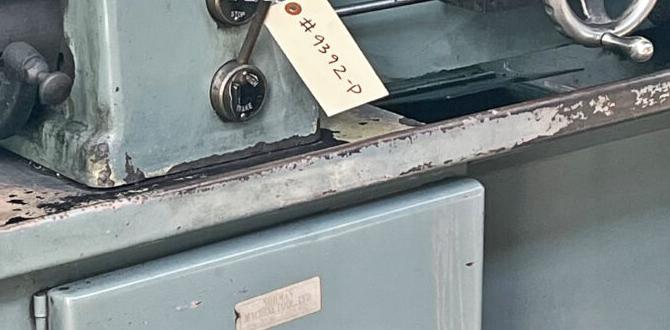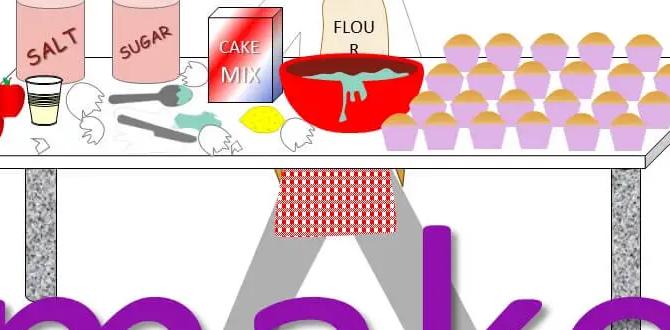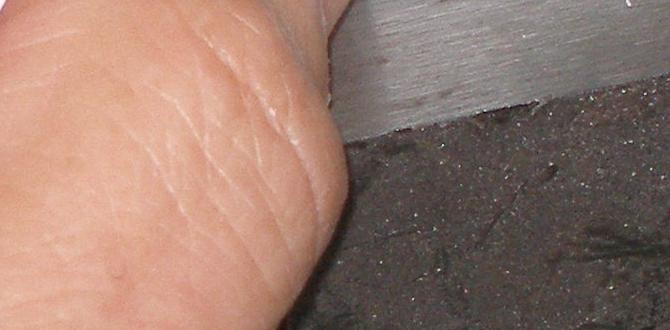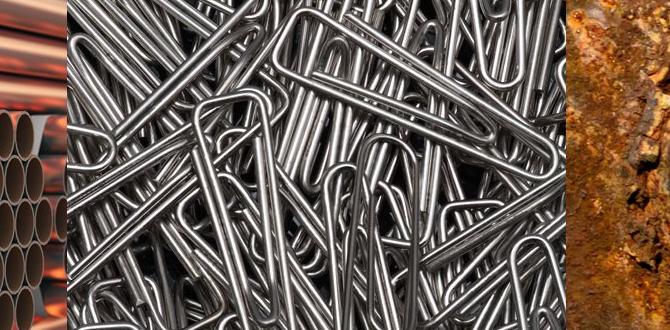Have you ever wondered how machines cut metal? It’s not just about sharp blades. One important factor is the milling cutter’s helix angle. This angle can make a big difference in how chips are removed. Think about it: if chips don’t clear away quickly, they can mess up the work.
Picture this: you’re using a milling cutter, but the chips are piling up like leaves in autumn. That doesn’t help anyone! A good helix angle helps the cutter slice through materials smoothly, making chip evacuation easy and efficient.
Fun fact: the angle of the cutter can even affect the speed of your work. Knowing about milling cutter helix angles can help you pick the best tool for your job. Curious how this all works? Let’s dive deeper into the world of milling and discover the secrets behind chip removal!
Milling Cutter Helix Angle For Chip Evacuation Explained Milling Is A Crucial Process In Manufacturing And Machining, And The Effectiveness Of This Process Is Largely Influenced By The Design Of The Milling Cutter, Particularly Its Helix Angle. The Helix Angle Of A Milling Cutter Plays A Significant Role In Chip Evacuation, Which Is Essential For Maintaining The Efficiency And Accuracy Of Milling Operations. In This Article, We Will Explore What The Helix Angle Is, Why It Is Important, And How It Affects Chip Evacuation During The Milling Process. Understanding Helix Angle The Helix Angle Refers To The Angle Formed Between The Cutting Edge Of The Tool And The Axis Of Rotation Of The Milling Cutter. This Angle Can Vary Significantly Depending On The Application And Material Being Machined. A Well-Designed Helix Angle Can Improve Cutting Efficiency, Reduce Tool Wear, And Enhance The Overall Performance Of The Milling Operation. Importance Of Helix Angle In Chip Evacuation Chip Evacuation Is Critical In Milling, As Trapped Chips Can Lead To Overheating, Tool Breakage, Or Poor Surface Finish. The Helix Angle Significantly Influences How Chips Are Removed From The Cutting Zone. A Proper Helix Angle Allows Chips To Be Efficiently Pushed Up And Away From The Workpiece, Minimizing The Risk Of Re-Cutting And Ensuring Smooth Machining. Types Of Helix Angles 1. **Low Helix Angle (10°-30°)**: Generally Used For Soft Materials. This Angle Promotes Stability And Reduces Cutting Forces, But May Not Be As Effective For Chip Removal. 2. **Medium Helix Angle (30°-45°)**: A Balanced Approach Suitable For A Wide Variety Of Materials. This Angle Provides Good Chip Flow And Stability. 3. **High Helix Angle (Greater Than 45°)**: Ideal For Harder Materials. This Angle Improves Chip Evacuation And Reduces Cutting Forces, Making It Easier To Achieve A Better Finish. Conclusion Selecting The Right Milling Cutter Helix Angle Is Crucial For Effective Chip Evacuation And Overall Machining Efficiency. Understanding The Relationship Between Helix Angle And Chip Removal Can Greatly Enhance The Performance Of Milling Operations. By Optimizing This Angle Based On Materials And Machining Conditions, Manufacturers Can Improve Productivity And Tool Lifespan, Making It An Essential Consideration In The Milling Process.

Milling Cutter Helix Angle for Chip Evacuation
The helix angle of a milling cutter plays a big role in chip evacuation. A right angle helps chips move away quickly from the cutting area. This keeps the cutter cool and improves the cut quality. Did you know that a larger helix angle often leads to better surface finishes? Choosing the right angle can make your milling tasks easier and more efficient. Understanding how helix angles work can help anyone improve their machining skills.Understanding Helix Angle
Definition of helix angle in milling cutters. Importance of helix angle in machining processes.The helix angle is the twist of the cutting edge on a milling cutter. This twist helps shape and remove material from the workpiece. A good helix angle improves cutting by pulling chips away from the area. It also helps create a clean finish. The right angle helps prevent damage and ensures tools last longer. Choosing the correct angle can make machining faster and easier.
What is the importance of helix angle in machining?
The helix angle plays a key role in machining success. It influences how well the cutter works. A sharp angle helps with chip evacuation. This reduces heat buildup, making cutting safer and more efficient.
Key Benefits:
- Improved chip removal – Keeps the cutting area clear.
- Better tool life – Reduces wear on the cutter.
- Enhanced surface finish – Produces smoother surfaces.
Impact of Helix Angle on Chip Evacuation
Mechanism of chip evacuation based on helix angle. Comparison of different helix angles and their effects on chip removal.The helix angle of a milling cutter plays a big role in how chips are removed during machining. A larger helix angle helps lift chips away more easily. Think of it like a giant slide for chips! In contrast, a smaller helix angle might keep them stuck. Check out the table below to see how different angles impact chip removal:
| Helix Angle | Chip Evacuation |
|---|---|
| 15° | Slow evacuation, chips may clog |
| 30° | Moderate evacuation, some clogging |
| 45° | Efficient evacuation, chips flow freely |
For best results, a helix angle of around 45° is often preferred. It’s like the sweet spot for chip evacuation! So remember, choosing the right angle could save you from a messy milling session.
Factors Influencing Helix Angle Selection
Material type and properties. Cutting conditions and operating speeds.Choosing the right helix angle for cutting tools depends on two main factors: the material type and the cutting conditions. Different materials behave differently when cut. For example, soft materials need different angles than hard metals. Fast cutting speeds can require steeper angles to help move chips away easily. This makes sure the tool stays effective. Understanding these factors can make a big difference in cutting success.
How does material type affect helix angle?
Material type affects the helix angle. Soft materials may need a lower angle, while hard materials may benefit from a steeper angle. Use the right angle to match the material’s properties for better results.
Influencers of Cutting Conditions:
- Cutting speed
- Type of material being cut
- Coolant use
Optimal Helix Angles for Various Applications
Recommended helix angles for specific materials (e.g., aluminum, steel). Applications in different industries (automotive, aerospace, etc.).Choosing the right helix angle can make a huge difference in machining. For aluminum, a 30 to 45-degree helix angle is ideal. It helps chips escape quickly, making the process smoother. For steel, a 15 to 30-degree angle is better as it provides more strength. Industries like automotive and aerospace benefit from these precise angles. After all, no one wants to see a plane or car stalled by bad chips!
| Material | Optimal Helix Angle | Industry |
|---|---|---|
| Aluminum | 30-45° | Automotive |
| Steel | 15-30° | Aerospace |
Common Myths and Misconceptions about Helix Angles
Debunking myths related to low vs high helix angles. Clarifying the relationship between helix angle and tool wear.Many people think high helix angles are always better than low ones. This is not true. Low angles work well for certain tasks. They can help with chip evacuation without causing too much wear on tools. Many believe that a higher angle means more wear and tear, but that is not always the case. The right angle depends on the job.
- Low helix angles are great for softer materials.
- High helix angles can cut faster in harder materials.
- Tool wear also depends on the cutting speed and material type.
Understanding these facts helps in choosing the right milling cutter based on the project.
What is a common misconception about helix angles?
A popular belief is that a higher helix angle always leads to better chip evacuation. This is not true; both high and low helix angles serve different purposes based on material and task.
Measuring and Adjusting Helix Angles
Techniques for measuring helix angles accurately. Methods for adjusting helix angle in different types of milling cutters.Measuring helix angles is important for the performance of milling cutters. Use a ruler or a protractor for accuracy. Always check from multiple points to ensure precision. If adjustments are needed, different methods can help.
- For fixed-angle cutters, grind the edge at a specific angle.
- For adjustable models, use proper screws to tweak the angle.
- Maintain the balance of the cutter for better stability.
These steps will help improve chip evacuation and make cutting smoother!
How do I measure the helix angle accurately?
To measure the helix angle accurately, use a protractor or digital angle finder. These tools provide clear readings. Always double-check your measurements for better results.
What methods can I use to adjust the helix angle?
- For fixed cutters, adjust with the grinding machine.
- For adjustable cutters, turn screws according to the specs.
Future Trends in Milling Cutter Design
Innovations in helix angle design for enhanced chip evacuation. Role of advanced materials and coatings in optimizing performance.New milling cutters are changing how we make things. Designers are now focusing on helix angles that help chips move away easily. This means smoother cutting. Advanced materials and special coatings make these tools last longer and work better. Imagine cutting metal without getting stuck! These improvements keep machines running efficiently.
What are the future trends in milling cutter design?
The future of milling cutter design focuses on two main areas:
- Innovative helix angle designs for better chip evacuation.
- Advanced materials and coatings to improve tool performance.
Conclusion
In conclusion, the helix angle of milling cutters plays a big role in chip evacuation. A proper angle helps clear chips effectively, improving cutting performance. You can experiment with different angles for better results. Remember, understanding how this works can enhance your projects. Keep learning about tools and techniques to boost your skills in milling. Happy cutting!FAQs
Here Are Five Questions Related To Milling Cutter Helix Angle And Its Impact On Chip Evacuation:The helix angle on a milling cutter is the twist you see on the cutting edge. When we change the angle, it helps chips, or scraps, move away easily. A bigger angle usually makes chip removal better. This keeps the cutter clean and makes it work faster. So, a good helix angle helps us get the job done smoothly!
Sure! Please provide me with the question you’d like me to answer.
How Does The Helix Angle Of A Milling Cutter Influence The Effective Removal Of Chips During The Machining Process?The helix angle of a milling cutter affects how well it removes chips, which are tiny bits of metal. A larger angle helps the cutter lift chips away quickly. This means less chance of clogging and smoother cutting. With the right angle, you get better results and a cleaner workspace. So, choosing the right helix angle makes machining easier and more efficient.
What Are The Optimal Helix Angles For Different Materials When It Comes To Maximizing Chip Evacuation?The best helix angles for cutting tools depend on what material you’re working with. For soft materials, like aluminum, a helix angle of 30 to 45 degrees works well. For harder materials, like steel, angles between 15 and 30 degrees help. These angles make it easier to move chips away while cutting. Using the right angle keeps things running smoothly and prevents problems.
How Can Changes In The Helix Angle Affect The Surface Finish Of The Machined Component?Changing the helix angle affects how the tool cuts the material. A steeper angle can make smoother surfaces, while a shallower angle might leave rough spots. This happens because the angle changes how the tool contacts the material. If we pick the right angle, we can make our finished piece look really nice and smooth.
What Role Does Helix Angle Play In Reducing Cutting Forces And Improving Tool Life During Milling Operations?The helix angle is the angle of the cutting edge on a tool. A bigger helix angle helps the tool slice through metal better. This means the tool doesn’t have to push as hard, which makes cutting forces smaller. With less pressure, the tool lasts longer and works better. So, using the right helix angle can make cutting easier and help your tools stay sharp.
How Do Various Helix Angles Impact The Flow Of Chips In Cnc Milling Versus Manual Milling Processes?Helix angles change how chips get pushed away when cutting metal. In CNC milling, which is computer-controlled, the chips flow smoothly because the machine can adjust better. If the angle is right, it helps chips slide off easily. In manual milling, you have less control, so chips may not flow as well. This can make cutting harder and messier.






